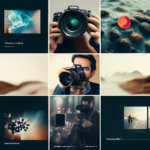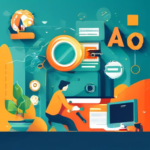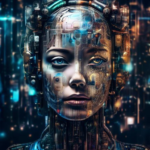Picture this: You’re deep into your latest creative project, and you’re inching closer to that perfect manifestation of your vision. But there’s a hitch. You need an image—something that speaks a thousand words, fits like a puzzle piece, and elevates your creation from good to jaw-dropping. Enter the world of AI-generated stock images. If you’re like most people, the allure of endless, unique visuals at your fingertips sends your imagination racing. Yet, the way to effectively harness this modern marvel might seem like uncharted territory. Fear not, creative soul. This guide is your treasure map, designed to transform you into an expert navigator of the dazzling realm of AI stock images. Let’s embark on this journey together and see how you can seamlessly integrate these impeccably crafted visuals into your projects, making them shine brighter than ever before.
Table of Contents
- Selecting the Right AI Image Generator for Your Needs
- Ensuring Quality and Authenticity in AI-Generated Images
- Customizing AI Images to Match Your Project’s Aesthetic
- Integrating AI Images Seamlessly into Visual Design
- Navigating Copyright and Usage Rights with AI Stock Images
- Balancing AI Creations with Human Creative Input
- Optimizing Image Formats and Resolutions for Different Platforms
- Ethical Considerations When Using AI in Visual Projects
- Final Thoughts
Selecting the Right AI Image Generator for Your Needs
When diving into the world of AI-generated images, choosing the right tool can make or break your project’s aesthetic and efficiency. Given the myriad choices available, it’s essential to align the capabilities of the image generator with your specific requirements. Here’s how you can navigate this landscape effectively.
Identify Your Primary Usage. Are you looking for hyper-realistic stock photos, or do you need more abstract, artistic visuals? Some AI image generators excel at creating lifelike images, while others shine in producing unique, stylized content. Knowing your focus will help narrow down your options quickly.
- **Realistic Photos**: Ideal for marketing materials, product shots, and professional presentations.
- **Abstract Images**: Best for creative projects, social media content, and inspirational visuals.
Evaluate Image Quality and Customization Features. Not all AI image generators offer the same level of refinement or customization. Look for generators that provide high-resolution images and advanced editing options. Some tools allow you to adjust lighting, add textures, or even combine elements from multiple images to craft something truly unique.
| Generator | Best Feature | Limitations |
|---|---|---|
| Tool A | High Realism | Limited Customization |
| Tool B | Creative Flexibility | Lower Resolution |
Consider Costs and Subscription Models. Budget constraints are a significant factor. While some AI image generators offer free trials or pay-per-image models, others require a monthly or yearly subscription. Balance the cost against the value provided, especially if you plan to use the tool frequently.
think about **Integration Capabilities**. Check if the AI image generator can be easily integrated into your existing workflow, be it through APIs, plugins, or direct download options. Seamless integration can save you hours in the long run and boost your productivity.
Ensuring Quality and Authenticity in AI-Generated Images
When using AI-generated images, ensuring quality and authenticity can be a formidable task. Unlike traditional stock images, AI-generated visuals require extra vigilance to ensure they meet professional standards and enhance your project’s credibility. Mistakes can be detrimental, but with the right approach, you can seamlessly integrate these futuristic assets.
1. Check for Consistency: AI can sometimes generate images with inconsistencies, such as mismatched lighting or disproportionate elements. To avoid these pitfalls:
- **Examine details:** Look at shadows, reflections, and object sizes.
- **Compare elements:** Match the style and quality across all images used in your project.
- **Use editing tools:** Employ software like Photoshop to correct inconsistencies.
2. Authenticate for Realism: Authenticity in AI-generated images is vital. They should appear as though captured through a camera lens, without giving away their algorithmic origins. Here are some strategies to enhance realism:
- **High-resolution formats:** Always opt for the highest quality versions to avoid pixelation.
- **Realistic textures:** Check for lifelike textures and surface details.
- **Background integration:** Ensure that objects blend seamlessly with their backgrounds.
Utilizing a standardized checklist can also help keep your project on track:
| Check | Description |
|---|---|
| Lighting | Consistent throughout the image |
| Resolution | High enough for intended use |
| Backgrounds | Seamlessly integrated and coherent |
3. Collaborate with Professionals: Sometimes, a second pair of eyes can make all the difference. Collaborative platforms or professional designers can offer valuable feedback. Here are some ways to integrate professional insights:
- **Peer reviews:** Engage with a network of creatives for pre-launch feedback.
- **Professional consultations:** Hire a design expert to vet the AI-generated images.
- **Client feedback:** If applicable, let your clients preview and suggest improvements.
Customizing AI Images to Match Your Project’s Aesthetic
Creating a cohesive visual story is essential, and AI-generated images can be tailored to enhance the unique vibe of your project. With the right tweaks, these images can blend seamlessly into your project’s aesthetic. Here are a few key strategies to help you achieve that harmonious look and feel.
**1. Color Palette Synchronization:** Make sure your AI images align with your project’s color scheme. Tools like Adobe Color can help you extract the dominant colors from your project assets, providing a palette you can reference. Match these colors in your AI images by tweaking them using photo editing software or online tools.
**2. Consistent Mood and Tone:** The emotional resonance of an image is critical. Determine the mood you’re aiming for—whether it’s bright and cheerful, dark and mysterious, or somewhere in between. Adjust contrast, brightness, and saturation to ensure the AI images emit the desired energy. Here is a quick guide:
| Mood | Adjustment Tips |
|---|---|
| Cheerful | Increase brightness and saturation |
| Moody | Reduce brightness, increase contrast |
| Neutral | Balance all settings, muted colors |
**3. Supporting Elements:** Make use of overlays, filters, and textures to further integrate AI images into your project’s overall design. Vignettes can add a classic touch, while grain effects can introduce a vintage feel. Subtle overlays can transition an AI image from striking to component.
**4. Typography and Composition:** Design isn’t just about images; it’s also about how they merge with text and other elements. Ensure cohesive typography that complements the images you’ve selected. Pay attention to composition—place images strategically to guide the viewer’s eye across your content.
By following these techniques, you can craft stunning visuals that both enhance and unify your projects, making the integration of AI-generated images not just seamless but an essential part of your design process.
Integrating AI Images Seamlessly into Visual Design
When you’re harnessing the power of AI-generated images, one of the pivotal aspects lies in ensuring they blend effortlessly with your existing visual schemes. **Start with consistency**: your AI images should reflect the style, color palette, and tone of your brand. This isn’t just about aesthetics; it’s about crafting a cohesive narrative that resonates with your audience.
Here’s how to achieve that seamless integration:
- Color Matching: Use tools like Adobe Color or Coolors to extract and match the palettes of your AI images with your brand colors.
- Resolution and Quality: Maintain high-resolution images to ensure clarity and avoid pixelation. Tools like TinyPNG can help optimize without loss of quality.
- Visual Consistency: Standardize filters, textures, and styles across your images. This helps maintain a uniform look and feel.
**Layer AI images with graphical elements**: Incorporate images with other design components such as text overlays, icons, or borders that align with your branding. For example, if your brand leans towards minimalism, integrate simple, clean lines and understated typography to complement the images.
| Tip | Description |
|---|---|
| Color Palette | Ensure the AI image colors fit your brand’s main hues. |
| Resolution | High-quality images prevent pixelation. Use optimization tools smartly. |
| Consistency | Uniform styles enhance visual coherence. |
**Experiment and Adapt**: Don’t be afraid to test multiple variations. A/B testing can be particularly useful here, allowing you to determine what resonates best with your audience. The flexibility of AI-generated images makes them ideal for iterative design processes.
Ultimately, the goal is to make the AI-generated visuals feel like a natural extension of your brand’s identity. When used thoughtfully, these images can significantly enhance your project’s appeal and effectiveness.
Navigating Copyright and Usage Rights with AI Stock Images
Navigating the realm of copyright and usage rights for AI-generated stock images can be a bit tricky. Unlike traditional stock photos, AI images often involve multiple layers of intellectual property. It is crucial to understand these nuances to ensure you’re operating within legal boundaries while benefiting from the stunning visuals AI technology can offer.
**Key Considerations:**
- Licensing Agreements: Always verify the licensing agreement of the AI stock images. Some images may be royalty-free but come with restrictions on how they can be used commercially or edited.
- Attribution Requirements: Some sources require attribution to the creator or platform. Not including proper attribution can lead to copyright infringement.
- Purpose and Context: Ensure the image’s usage aligns with its intended purpose. For example, using an AI-generated image designed for editorial use in a commercial ad without proper rights can lead to legal complications.
To provide clarity, here’s a simple guide on potential licensing terms you might encounter:
| License Type | Description |
|---|---|
| Royalty-Free | Permits multiple uses without additional fees, with possible restrictions on modification or distribution. |
| Rights-Managed | Usage is limited to specific parameters like duration, region, and medium, often more expensive. |
| Creative Commons | Varies from free to use with attribution to more restrictive licenses requiring specific usage rights. |
**Practical Tips:**
- Consult Legal Expertise: When in doubt, seek advice from a legal professional to ensure compliant use, especially for high-stakes projects.
- Keep Records: Maintain copies of your purchase and licensing agreements as proof of your rights to use the images.
- Monitor Usage: Regularly review where and how your images are being used to stay within the boundaries of your licensing agreement.
Understanding copyright and proper usage rights might seem cumbersome at first, but with careful attention and due diligence, you can efficiently navigate this landscape and make the most of AI stock images in your projects.
Balancing AI Creations with Human Creative Input
Integrating AI-generated stock images into your projects can open the door to a realm of new possibilities—letting AI handle routine visual tasks can free up precious time for truly inspired human creativity. However, striking the right balance between AI and human input can turn an ordinary project into a masterpiece. Here are some tips on how to achieve this harmonious blend:
- Leverage AI for Repetitive Tasks: AI excels at handling repetitive or bulk tasks, such as generating multiple variations of the same image or background. By automating these labor-intensive processes, you free yourself up to focus on more intricate and creative aspects of your project.
- Personalization Is Key: Although AI can produce stunning images, adding your personal touch can make the difference. Adjust colors, tweak compositions, or add unique elements that reflect your creative vision. This personal input elevates AI creations from generic to exceptional.
Consider the nature of your project and select the appropriate balance of AI and human ingenuity. Here’s a simple table to help you decide when to emphasize AI and when to rely more on human creativity:
| Project Element | AI Input | Human Input |
|---|---|---|
| Backgrounds | Generate multiple options | Final selection and customization |
| Product Images | Automate Bulk Edits | Style & Branding |
| Icons & Symbols | Basic Design Creation | Adapting Contextual Relevance |
Another practical approach involves blending AI-generated images with human-created elements. For instance, use AI to generate complex textures or ambient backgrounds and then layer your custom illustrations or text over them. This approach not only saves time but also ensures your project carries a signature style uniquely yours.
Remember, AI is a tool designed to complement human creativity, not replace it. By thoughtfully integrating AI stock images into your project and emphasizing where human input matters most, you can achieve a perfect symphony of efficiency and artistic expression.
Optimizing Image Formats and Resolutions for Different Platforms
When it comes to integrating AI stock images into your projects, choosing the right image formats and resolutions can significantly enhance the visual appeal and performance across different platforms. Here are some tips to ensure you hit the mark every time:
- Websites: For web-based platforms, **.JPEG** and **.PNG** are your best friends. JPEG offers good quality with smaller file sizes, perfect for web pages that need to load quickly. Meanwhile, PNG is excellent for images that require transparency or higher quality like logos and icons.
- Social Media: Each social media platform has its own preferred formats and dimensions. For Facebook, PNG works well for detailed images, while JPEG is suitable for everyday photographs. Instagram thrives on square format; aim for 1080 x 1080 pixels in JPEG. Twitter, on the other hand, benefits from PNG for images with text or graphics, maintaining a resolution of 1024 x 512 pixels.
- Print: When preparing images for print, **TIFF** and **EPS** formats are ideal due to their lossless quality, which ensures that every detail is preserved. Stick with a resolution of 300 DPI to guarantee the best print quality.
Here’s a quick reference table to help you choose the optimal format and resolution:
| Platform | Recommended Format | Resolution |
|---|---|---|
| Websites | JPEG / PNG | 72 DPI |
| JPEG / PNG | 1200 x 630 pixels | |
| JPEG | 1080 x 1080 pixels | |
| PNG | 1024 x 512 pixels | |
| TIFF / EPS | 300 DPI |
Remember, optimizing images isn’t just about following a set of rules; it’s about understanding the context of your project and leveraging the right tools. Next time you choose an AI stock image, think about where it will be used and pick the format and resolution that best matches your platform’s requirements. Your audience will thank you for it!
Ethical Considerations When Using AI in Visual Projects
Incorporating artificial intelligence into your visual projects offers a myriad of benefits, from enhanced creativity to increased efficiency; however, it also raises important ethical questions. As digital creators, it’s pivotal that we approach AI-generated stock images with **responsibility and mindfulness**.
- Copyright and Ownership: Ensure that the AI stock images you use are properly licensed. Always verify the terms and conditions associated with each image to avoid potential legal issues. Opt for reputable platforms that clearly outline the usage rights of their AI-generated content.
- Representation and Bias: AI algorithms are only as good as the data they are trained on, which can lead to biased outputs. Be cautious about how the imagery represents different demographics such as age, gender, and ethnicity. Strive for inclusivity and diversity in your visual content to avoid perpetuating stereotypes.
Transparency is another cornerstone of ethical AI usage. When utilizing AI-generated images, **consider disclosing** this aspect to your audience. Transparency fosters trust and allows viewers to engage with your content in an informed manner. It also opens doors for constructive dialogue around the integration of AI in creative processes.
| Ethical Aspect | Actionable Steps |
|---|---|
| Copyright and Ownership | Verify licenses, use reputable platforms |
| Representation and Bias | Ensure inclusivity and diversity |
| Transparency | Disclose AI usage to audiences |
Another key consideration is the potential socioeconomic impact. The rise of AI-generated stock images may affect the livelihoods of photographers and illustrators. As you integrate AI into your projects, balance its use by still **supporting human-created content**. Purchase images from freelancers and artists to foster a sustainable creative ecosystem.
In sum, while AI stock images present fantastic opportunities for innovation, approaching their use with careful ethical considerations ensures that your projects remain respectful, inclusive, and legally compliant. This balanced approach helps in leveraging AI’s capabilities while still honoring the human elements of creativity.
Final Thoughts
Now that you have learned how to seamlessly integrate AI stock images into your projects, the possibilities are endless. Let your creativity run wild as you explore the vast collection of images at your fingertips. Remember, AI technology is here to enhance your work, not replace it. So go forth and create something truly amazing with the power of AI by your side. Happy creating!
































